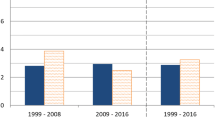Abstract
Credibility of European Economic Convergence. — The authors analyze economic convergence and its relation to European real interest rate differentials using a clustering method on seven macroeconomic key variables for 1979–1995. The results indicate that monetary convergence has progressed considerably but that there is hardly any real convergence in the EU. They also perform pooled nominal and real interest rate regressions with the individual cluster indicators as explanatory variables. The authors find significant positive effects of external (current account) and internal (unemployment ratios, government finance) imbalances on real interest rates. They also group countries according to economic reputation and find that real indicators remain significant for the high-reputation countries.
Zusammenfassung
Zur Glaubwürdigkeit europäischer Konvergenz. — Die Verfasser untersuchen wirtschaftliche Konvergenz und ihre Beziehung zu europäischen realen Zinsdifferenzen. Dabei benutzen sie ein Cluster mit sieben makroökonomischen Schlüsselvariablen für 1979–1995. Die Ergebnisse deuten darauf hin, daß die monetäre Konvergenz erheblich zugenommen hat, daß es aber kaum eine reale Konvergenz in der EU gibt. Die Autoren führen außerdem Querschnittsregressionen für nominale und reale Zinsen mit den einzelnen Indikatoren aus dem Cluster als erklärende Variable durch. Sie ermitteln signifikante positive Effekte von externen Ungleichgewichten (Leistungsbilanz) und internen Ungleichgewichten (Arbeitslosigkeit, Staatsfinanzen) auf die realen Zinssätze. Zudem gruppieren sie Länder nach ihrer ökonomischen Reputation und stellen fest, daß die realen Indikatoren für die Länder mit hoher Reputation signifikant bleiben.
Similar content being viewed by others
Explore related subjects
Discover the latest articles and news from researchers in related subjects, suggested using machine learning.References
Artis, M.J., and W. Zhang (1996). Business Cycles, Exchange Rate Regimes and the ERM: Is There a European Business Cycle? Robert Schuman Centre, EUI Working Papers 96/55. San Domenico.
Barro, R.J., and X. Sala-i-Martin (1990). World Real Interest Rates.NBER Macroeconomics Annual 1990:15–74.
Bayoumi, T., and B. Eichengreen (1993). Shocking Aspects of European Monetary Integration. In F. Torres and F. Giavazzi (eds.),Adjustment and Growth in the European Monetary Union. London: CEPR, and Cambridge: CUP.
Biltoft, K., and C. Boersch (1992). Interest Rate Causality and Asymmetry in the EMS.Open Economies Review 3(3): 297–306.
Bini Smaghi, L. (1994). EMS Discipline: Did it Contribute to Inflation Convergence?Banco Nazionale del Lavoro, Quarterly Review 47(June): 187–197.
Buiter, W.H., G. Corsetti, and N. Roubini (1993). Sense and Nonsense in the Treaty of Maastricht.Economic Policy 16:28–49.
Cumby, R.E., and F.S. Mishkin (1986). The International Linkage of Real Interest Rates: The European-US Connection.Journal of International Money and Finance 5(1):5–23.
De Grauwe, P. (1994a).The Economics of Monetary Integration. Oxford: Oxford University Press.
— (1994b). Towards European Monetary Union without the EMS.Economic Policy 17:147–185.
— (1996a). The Economics of Convergence: Towards Monetary Union in Europe.Weltwirtschaftliches Archiv 132(1): 1–27.
— (1996b). Monetary Union and Convergence Economics.European Economic Review 40(3/5): 1091–1101.
De Grauwe, P., and D. Gros (1991). Convergence and Divergence in the Community’s Economy on the Eve of Economic and Monetary Union. In P. Ludlow (ed.),Setting European Community Priorities. Brussels and CEPS.
Everitt, B.S. (1993).Cluster Analysis. London: Edward Arnold.
Goodhart, C. (1996). European Monetary Integration.European Economic Review 40(3/5): 1083–1090.
Gros, D., and N. Thygesen (1992).European Monetary Integration: From the European Monetary System to European Monetary Union. London: Longman.
Jacquemin, A., and A. Sapir (1996). Is a European Hard Core Credible? A Statistical Analysis.Kyklos 49(2): 105–117.
Kendall, M. (1980).Multivariate Analysis. London: Charles Griffin & Company Ltd.
Knot, K.H.W. (1995). On the Determination of Real Interest Rates in Europe.Empirical Economics 20(3): 479–500.
Knot, K.H.W. (1996).Fiscal Policy and Interest Rates in the European Union. Aldershot: Edward Elgar.
Koedijk, K.G., and C.J.M. Kool (1992). Dominant Interest and Inflation Differentials within the EMS.European Economic Review 36(4): 925–943.
Koedijk, K.G., C.J.M. Kool, and T.R.P.J. Kroes (1994). Changes in World Real Interest Rates and Inflationary Expectations.Weltwirtschaftliches Archiv 130(4):712–729.
Milligan, G.W. (1981). A Review of Monte Carlo Tests of Cluster Analysis.Multivariate Behavioral Research 16(4): 379–407.
Orr, A., M. Edey, and M. Kennedy (1996). Real Long-Term Interest Rates: The Evidence from Pooled-Time-Series.OECD Economic Studies 25:75–107.
Quirk, P.J. (1994). Fixed or Floating Exchange Regimes: Does it Matter for Inflation? IMF Working Paper WP/94/134. Washington, D.C.
Van Poeck, A., and J. Van Gompel (1994). Dominant Interest and Inflation Differentials within the EMS: A Comment.European Economic Review 38(8): 1661–1663




